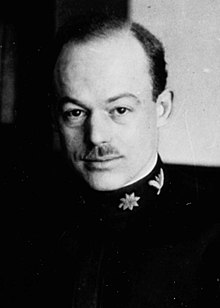Jerome Clarke Hunsaker | |
|---|---|
 Lt. Cmdr. Hunsaker, circa 1917 | |
| Born | August 26, 1886 |
| Died | September 10, 1984 (aged 98) |
| Citizenship | American |
| Alma mater | |
| Known for | pioneering research in aeronautics |
| Awards |
|
| Scientific career | |
| Fields | Aeronautics |
| Institutions | |
| Military career | |
| Allegiance | |
| Service | |
| Years of service | 1904–1926, 1942–1951[1] |
| Rank | |
| Battles / wars | World War I World War II[1] |
| Awards | Navy Cross Distinguished Service Cross[1] |
Jerome Clarke Hunsaker (August 26, 1886 – September 10, 1984) was an American naval officer and aeronautical engineer, born in Creston, Iowa, and educated at the U.S. Naval Academy and the Massachusetts Institute of Technology. His work with Gustav Eiffel outside Paris led to the first wind tunnel in the US at MIT. He was instrumental in developing a weather reporting and airway navigation. Hunsaker was also pivotal in establishing the theoretical and scientific study of aerodynamics in the United States. And he was primarily responsible for the design and construction of the Navy-Curtiss airplane (NC-4) that accomplished the first transatlantic flight (May 1919), and the first successful shipboard fighter. Later he championed lighter-than-air flight but the loss of the Navy airship he designed, the USS Akron, led to the withdrawal of federal support. His WW2 chairmanship of the National Advisory Committee for Aeronautics (NACA) was notable for favouring the development of existing aircraft designs rather than experimenting with turbojets or missile technology.